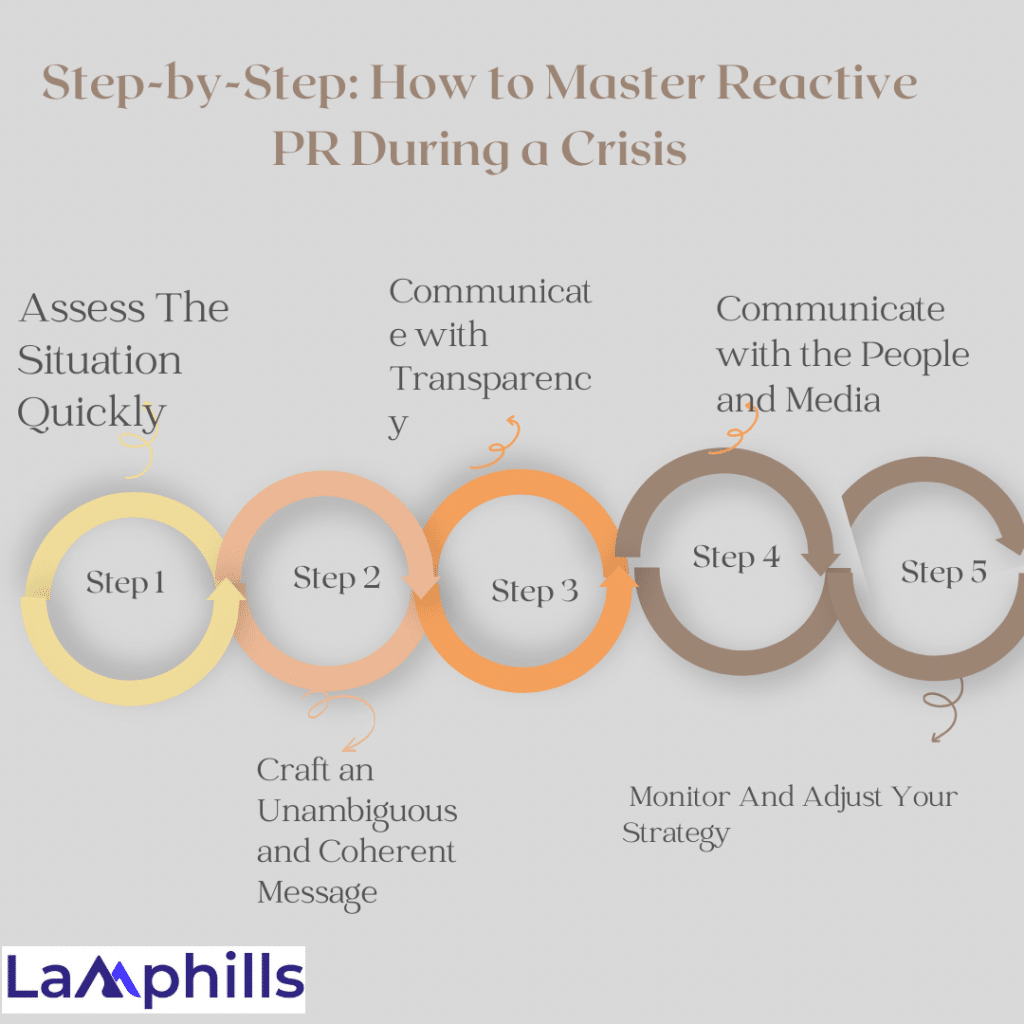A brand’s reputation can be made or broken by a single tweet or post in the fast-paced world of today. I have personally witnessed how a well-thought-out crisis reaction can transform a potentially disastrous circumstance into a tale of resiliency, and it is these insights that have taught me the real value of reactive public relations. Since the public relations (PR) sector is always evolving, it’s critical to maintain control over your brand’s reputation while being flexible and aware of current trends. To develop a strategy that guarantees your brand stays in touch with its values and vision and what is happening in your sector and the wider world, it is essential to understand the distinction between proactive and reactive PR.
Reactive PR and proactive PR are the two main subcategories of public relations. An organization’s goals and conditions determine which style it will support most of the time. You’ve come to the correct place if you’re a little confused about the realm of reactive PR. Everything you need to know about reactive PR, including how it varies from proactive PR, will be covered in this guide.
What is a Reactive PR?
The art and science of reacting to unforeseen circumstances that may have an effect on your brand’s reputation is known as reactive PR. Reactive PR is all about handling the problem when things go wrong, as opposed to proactive PR, which focuses on crafting campaigns and controlling the narrative to create a good perception.
When you identify a momentary opportunity to secure links and media for a brand, that’s known as reactive PR. Reactive public relations campaigns typically include the following characteristics.
- Unplanned. They’re not always unplanned, but most of the time at the very least there is significantly less planning time and roadmapping.
- Unscheduled activation. In many cases, reactive PR opportunities come in response to an event or emerging trend.
- Controlled messaging. This is one of the few similarities between proactive and reactive PR. In both instances, you should have a degree of control over the messaging. This isn’t true for crisis communications and issue management. It is broadly true and indeed an objective of both reactive and proactive PR.
- Outbound media relations. This is another similarity. Reactive PR can involve a degree of outbound media relations activity, but…
- Inbound media relations. This is a key difference. It’s rare (and often very exciting) for publicists who deal with inbound media inquiries. The one big caveat here is that the excitement often turns to anxiety if you’re dealing with a crisis comms scenario.
Successful Examples of Reactive PR

Want to see reactive PR in action? Here are some examples of successful strategies:
#1. Minty
Not to brag, but over the years, we’ve carried out some amazing reactive PR efforts. Our top pick was Admirals, a finance company trying to boost Google traffic. We needed to come up with a unique strategy to generate buzz around finance SEO because it can be a challenging topic. After deciding that reactive PR would be the best course of action, we made comments regarding the UK’s increasing rate of inflation and the rising cost of energy bills.
As a result, we distributed business-related news to websites devoted to particular industries across the target countries. The majority of the websites we contacted mentioned the business updates and included links to the Admirals website. Admirals was able to establish themselves as thought leaders in their field by responding to financial updates from major companies such as Disney and Amazon.
#2. IKEA
IKEA introduced the Euro 2020-inspired water bottle in 2020. During a press conference, Cristiano Ronaldo encouraged football fans to drink water instead of Coca-Colaafter removing two bottles of the official partner of that year’s Euros from the table.
IKEA followed suit after the water bottle trend went viral, releasing their own bottles with Ronaldo’s name on them. The brand was massively elevated in the discourse and made visible by the simple design that read “for water only.” All things considered, Ronaldo has the largest Instagram following.
How To Do Reactive PR

So, if you’re feeling brave and want to try out some reactive PR, here are some tips to make it happen.
#1. Troll Social Media Constantly
This is difficult, particularly for those of us who detest social media (but sometimes it can be difficult for those who adore it as well). Unfortunately, being aware of what’s going on and what people are talking about is necessary for an effective reaction. Having and keeping up a respectable social media presence is generally required, whether you want to or not.
#2. Enroll In Reactive PR Services
Numerous PR services are available that are specifically designed to link journalists and subject matter specialists. Hot comments on the day’s top stories from experts are frequently sought after by journalists. These platforms allow you to share your clients’
insights and get their names out there. The biggest one is Connectively (formerly HARO), but there are plenty of great and growing alternatives.
#3. Share Your Expertise
Narratives and counter-narratives are fundamental to contemporary debate. Do you have a viewpoint on a trending issue? Do you wish to challenge the current state of affairs? Offering your viewpoint as a legitimate subject matter expert is a fantastic method to be responsive and pose thought-provoking questions for the sector.
#4. Show Adaptability
Many PR and communications teams lack the flexibility needed to produce good reactive PR. It frequently calls for swift action, prompt decision-making, and prompt approval of initiatives.
#5. Go Get Reactive (PR)
Reactive PR often consists of experimenting to find what works. Reactive PR necessitates on-the-spot, genuine engagement in contrast to more deliberate, strategic, and proactive tactics. Experiment, find what works, and enjoy yourself a little while doing it.
It’s crucial to set realistic expectations and understand that coverage is not assured because reactive PR may not be suitable for every industry. Certain industries will receive more regular newspaper coverage than others.
Online and offline, reactive and proactive public relations are all essential components of any effective PR plan that reach your target audience and are consistent with your company’s vision and values.
Effective Strategies For Implementing Reactive PR
When it comes to remaining timely and relevant in the fast-paced world of B2B earned media, reactive PR can be just as crucial as proactive PR. Reacting promptly to breaking news and popular subjects can help you establish your brand as an authority in your industry and raise your profile in search results. This may result in higher website traffic, brand recognition, and eventually, new business prospects. Among these are:
#1. Configuring News notifications
Making the most of impending possibilities in reactive PR requires constant attention to detail because the field moves quickly. One easy approach to stay up to date on brand-related events and conversations is to set up news alerts.
on straight away. It also saves you from trawling the internet for hours before you find a suitable story. Also, have your notifications turned on on social media apps like Twitter, plus Google Alerts to track specific keywords in stories.
#2. Find The Experts
After deciding which story to jump on, you must ensure that your team has an expert who can provide analysis with accuracy and professionalism. If your firm might benefit from the narrative but you don’t have a thought leader within your brand, look through your media list for people who have already offered commentary on the topic. The most important thing to remember is to always make sure you can respond to the story. Even if the story is a wonderful fit for your business, you won’t be taken seriously if you can’t offer reliable facts.
#3. Everything Revolves Around Speed
Naturally, having news notifications set up aids in this. Usually, opportunities arise at very short notice—sometimes all you have is one or two days to act. At this time, it’s vital you not only put your brand at the center of the conversation but also ensure the opportunity is vetted to avoid any negative publicity.
Plus, the faster you respond, the more chance your brand has of being the first voice on the matter, which naturally generates more publicity and gives you a higher chance of becoming the thought leader on the subject.
Proactive vs. Reactive Pr: What’s The Difference?

Proactive and reactive PR are the two primary strategies that PR experts frequently discuss when it comes to managing a brand’s public image. Being able to distinguish between them is essential to becoming an expert in public relations since each has a distinct job and approach. Though their goals and techniques differ, both strategies are important parts of a business’s total PR plan. An in-depth examination of their differences is provided below:
#1. Timing
Like a fire drill, reactive public relations occurs when an unexpected requirement arises and you have to take quick action. For instance, you might only have a few hours to prepare a reaction if a celebrity tweets anything unfavorable about your company before the situation gets out of hand.
Proactive PR, on the other hand, is all about time and preparation. It’s similar to sowing seeds and watching them grow over time. A proactive effort, such as a brand awareness campaign or the launch of a new product, may take weeks or months to prepare. The payoff is consistent but incremental, and you have complete control over the message and pace.
In my experience, having a good balance between the two is essential. I’ve seen companies that are always in reactive mode, never having time to plan, and they end up constantly putting out fires. On the flip side, I’ve also worked with brands that focus only on proactive PR, but when a crisis hits, they’re caught off guard. The real sweet spot is being prepared for both.
#2. Focus
An issue or crisis that could damage your brand’s reputation is what reactive public relations is all about. Like lifeguards on the beach, you hope you never need them but are grateful they’re there in case of serious waves. Preventing a bad story from causing irreversible harm to your brand is the main goal of damage management.
To demonstrate to the public that they are taking food safety concerns seriously, a restaurant’s reactive public relations team may, for example, issue a statement, provide refunds, and make safety changes.
A proactive approach to public relations, however, centers on crafting uplifting stories that gradually enhance your company’s reputation. Showing off what makes your brand unique is similar to being its cheerleader and explaining why people should care about it. It’s all about leveraging opportunities to tell your story in a positive light.
#3. Control
Reactive public relations involves reacting to previously published content. You are only responding to the story; you do not influence it. You must prepare a reaction that responds to a competitor’s statement that is critical of your business, for instance, without making matters worse. It’s comparable to playing defense when you’re responding to the other team’s moves on the basketball floor.
I used to work for a fashion brand that had to respond to complaints about a new product line’s quality. We had to act fast to address the issue after it became widely apparent on social media and provide a detailed explanation of the quality control measures being implemented to address the issue. Although we did not influence the original story, our response served to guide it in a better direction.
Proactive PR, however, allows you to be the storyteller. You decide what stories to share, what values to highlight, and when to do so. It’s like being the director of a movie—you’re crafting the plot and guiding the audience’s perception. For example, when launching a new eco-friendly initiative, a company can use proactive PR to tell the world about its commitment to sustainability before anyone else has a chance to criticize its efforts.
#4. Approach
Being proactive makes you the biggest supporter of your company. Proactive public relations allows you to choose and share the stories that best represent your destination or attraction—those that are distinctive, captivating, and different. Most individuals think about being proactive while developing a public relations plan. It all comes down to proactive outreach—assuming the initiative to spread the word and identifying the appropriate media outlets and individuals with whom to collaborate.
Reactive public relations focuses more on reacting correctly to opportunities and situations that present themselves than it does on actively pursuing leads. It may have a negative connotation because it is typically associated with a “sit back and wait” strategy. Still, a good reactive public relations strategy does take work, consideration, and preparation. You have to know who the right people are within your organization to respond quickly to certain leads, what your key messaging is, and how to properly position yourself as an expert in the moment.
#5. Strategy
A proactive outreach public relations strategy’s main components and greatest time investment are often pitching and active outreach. Create media themes and angles centered around the tales you want to tell first, then segment them by month or season based on the subject matter, the time of year, and any noteworthy events like holidays or anniversaries that lend the subject more significance.
As soon as you’ve determined your content objectives, proactively seek out at least five media outlets and contacts who could be interested in a certain subject—a culinary writer for a BBQ hotspot piece or a family vacation writer for a new ropes course, for example.
example. Consider your ask when pitching—what is the action you want the writer to take? Is this fit for a particular column or section of their website? An interview opportunity? An invitation to schedule a FAM and see the attraction in person? Active and individualized outreach allows you to pique the writer’s interest and develop stories that benefit both publication and destination, mutually.
On the other hand, the fastest approach to get your company new leads and media chances is to look for and build strong connections. This can be done through your neighborhood travel agency, a larger regional one, or even the state agency that encourages travel. Additional partnerships may arise from your destination’s main points of interest, neighboring DMOs, or specialized cooperative initiatives that suit your needs.
Through partnerships, your location or business can become part of a broader story and brand, leading to greater publications and features that you would not have been able to handle on your own. Additionally, since you will have numerous individuals and programs dedicated to sharing your story, they offer the opportunity for more pitches and increased outreach stories.
#6. Contact Generation
Proactive media appearances and one-on-one deskside meetings are excellent means of making new contacts or establishing a rapport with writers you’ve been attempting to reach but haven’t previously collaborated with. Look for events that are held in your intended geographic areas or that have an attendance list that includes just professionals in your field. Make a target list for desksides, send out an email to potential customers, and schedule a time, day, and place for a meeting.
Then, you can receive fresh requests or follow-up visits to your destination from your previous contacts. Building a media list is a continuous process that is never finished.
type of relationship. Even if you’ve hosted a writer or appeared in their publication in the past, don’t discount the power of repeat coverage. Keep the relationship strong by responding quickly and offering information, interviews, images, etc.
You also have the advantage of knowing their requirements and how they operate if you have previous experience with media relations. Additionally, they are probably coming back to you because of your prior achievements; both of them have built a certain amount of trust. This trust may pave the way for more direct discussions, chances to explore different perspectives, and easier access to media for the stories you think are most important.
Step-by-Step: How to Master Reactive PR During a Crisis

Follow the steps below.
#1: Assess The Situation Quickly
The first stage is to quickly compile the facts. What took place? Who is impacted? Is this a small-scale problem or something larger? I’ve discovered that while it’s simple to react emotionally when things are tense, it’s best to pause and consider the whole picture to avoid overreacting.
#2: Craft an Unambiguous and Coherent Message
The next step is to draft an honest, succinct, and unambiguous statement. A small batch of items was impacted by an error in their production process that one of my clients had to deal with. Rather than attempt to minimize it, we choose to be transparent and provide a heartfelt apology along with complimentary replacements. The customers’ trust in us was well-earned, and the transparency we provided was worth more than the initial mistake.
#3: Communicate with Transparency
Establishing trust is crucial, particularly in times of crisis. Talk about what you know, what you’re doing to address it, and how it affects your clientele. A delayed shipment caused irate customers to take to social media on one occasion. We apologized for any difficulty caused and promptly recognized the delay by sharing updates. Customers who appreciated our honesty sent us words of gratitude instead of possible negative feedback because of our proactive communication.
#4: Communicate with the People and Media
Engagement is important, but it must be executed well. When responding to media inquiries, stick to the facts rather than conjecture, and act professionally and courteously on social media. One instance that comes to mind is when a reporter asked me for my opinion on a bad article. By providing a detailed response and additional context, we were able to shift the narrative in the final article, reducing the potential damage.
# 5: Monitor And Adjust Your Strategy
Keep a careful eye on the situation and modify your plan as the crisis develops. Are there any new problems emerging? Is the attitude of the public changing? You can maintain narrative control by being adaptable. I’ve seen this strategy perform incredibly well in a client’s PR problem when the initial messaging needed to be adjusted in response to client feedback. Our statement was improved, and the audience responded to it more favorably.
Importance of Reactive PR in Crisis Management

Below are a few reasons for the importance of Reactive PR in Crisis Management
#1. Builds Strong Relationships With Journalists
You can build trusting relationships with influential media figures by regularly interacting with journalists and sharing your insightful thoughts and ideas. Your brand will be more prominent in their minds when they are searching for quotes or professional opinions as a result of your continuous communication, which raises the likelihood that you will be mentioned in more news articles.
#2. Strengthens Your Authority And Leadership
By giving journalists these insights on a regular basis, you establish your reputation as a thought leader in your field. As a result, you are able to maintain your current clientele and draw in new ones by increasing your authority and reputation with your target demographic.
#3. It Increases Your Visibility
You’re making an effort to become more visible when you actively respond to queries from journalists. Your audience reach will only grow as a result of your increased likelihood of being mentioned in press releases and news articles. This is especially useful if you’re struggling to come up with press release ideas and content.
#4. Complete Command Over The Circumstances
Even though crises might differ in scope and character, you need to respond quickly to protect your company from harm. Reactive public relations can come in handy while handling crisis management.
This is because, regardless of the problem, it enables you to take charge of the circumstance and express your response. A thoughtfully crafted, responsive comment can act to diffuse any negative commentary by answering any questions about the situation without making it sound like a super big deal.
Reacting with a written statement also gives you complete control over the language you use to explain the issue, not to mention allowing you to be as detailed or as vague as you want. It’s also your words, which means you have less chance of being misquoted as a pose to speaking in an interview.
#5. Gaining Online Coverage
By putting your business at the center of ongoing discussions, reactive PR can help you reach a larger audience and build strong public awareness of your company. Reactive PR may frequently assist organizations in the business-to-business (B2B) sector in positioning themselves as industry experts and in obtaining regular opportunities for interviews and remarks. Reactive public relations is an excellent approach to developing links by obtaining internet attention. This improves your SEO rankings by attracting links from websites with high authority.
#6. Unlocking Expert Status
Being positioned as a subject matter expert is the main advantage of reactive PR. In terms of your clientele and prospective clientele, why not have the media come to you? They certainly don’t know that the media comes to you not just for your expertise, but because you’re reliable, available and quotable. There’s a reason we often see the same experts commenting on news stories. There are lots of other experts, but they’re not all primed and ready (or interested) to give their quotable, unique insights.
Final Thoughts
Reactive PR is an essential tactic for starting PR initiatives; it cannot be negated. It not only gives businesses lots of chances to interact with big, well-established audiences, but it also serves as an illustration of how they may rise to the position of thought leaders in their industries. It is, as we all know, crucial in terms of authority and trustworthiness for Google as well as potential clients. Reactive PR may help you make your world more accessible to others by being used as a marketing strategy—but only if the moment and the topic align with your brand.






